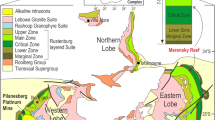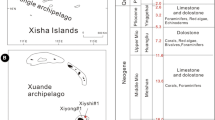Abstract
The Merensky Reef of the Bushveld Complex occurs in its highest stratigraphic position as a heterogeneous, pegmatitic, feldspathic melanorite bounded by two narrow chromitite stringers at the base of the Merensky Cyclic Unit (MCU). In the Swartklip Facies of the Rustenburg Layered Suite, the occurrence of widespread thermal and mechanical erosion termed “potholing” has led to the subdivision of the Merensky Reef into Normal Reef and Regional Pothole Reef sub-facies. The transition between the two sub-facies occurs where the MCU transgresses the lower chromitite stringer of the Normal Merensky Reef and cuts down into the underlying cumulate lithologies. In the Regional Pothole Reef at the Northam Platinum Mine, several economic reef types are identified, where the Merensky Reef becomes conformable to cumulate layering, in particular, to the footwall marker (NP2 reef type) and the upper pseudoReef (P2 reef type). The Normal Merensky Reef, as well as the P2 and NP2 Reefs, contains economic platinum group element (PGE) grades and includes the lower portion of the MCU melanorite and the Merensky Chromitite. Whole rock geochemistry indicates that this package is compositionally identical in Normal, P2, and NP2 Reefs, suggesting that the base of the MCU is a relatively homogeneous drape over both Normal and Regional Pothole Reef regions. However, the lower sections of the three Reefs are variables depending on the depth of transgression of the MCU. In the Normal and P2 reef types, transgression by the MCU was arrested within harzburgites, melanorites, and norites, resulting in coarse, pegmatitic textures in the immediate footwall units. For the NP2 Reef, transgression by the MCU was arrested within leucocratic rocks and resulted in the formation of troctolites below the Merensky Chromitite. These troctolites are characterised by a coupled relationship between olivine and sulphides and by changes in major element chemistry and PGE contents relative to equivalent units in the footwall of the Normal Reef. Along with micro-textural relationships, these features suggest that troctolization of leucocratic cumulates in the NP2 Reef beneath the Merensky chromitite was a result of a reactive infiltration of a chromite-saturated melt and an immiscible sulphide liquid from the overlying MCU, rather than a significant fluid flux from below. In all reef types, the concentration of S defines symmetrical peaks centred on the Merensky Chromitite (and chromitites from pre-existing cyclic units in Normal and P2 Reefs), whereas PGE concentrations define asymmetrical peaks with higher PGE contents in reconstituted footwall rocks relative to the MCU melanorite. This signature is attributable to a magmatic model of PGE collection followed by deposition towards the base of the MCU and within reconstituted footwall rocks. The continuity of the asymmetrical magmatic PGE signature between the Normal Reef and Regional Pothole Reef sub-facies indicates that PGE mineralization inherent to the Merensky magma occurred as a drape over a variably eroded and subsequent texturally and geochemically reworked or reconstituted footwall.












Similar content being viewed by others
References
Ballhaus CG (1988) Potholes of the Merensky Reef at Brakspruit Shaft, Rustenburg platinum mines; primary disturbances in the magmatic stratigraphy. Econ Geol 83:1140–1158
Ballhaus CG, Sylvester P (2000) Noble metal enrichment processes in the Merensky Reef, Bushveld Complex. J Petrol 41:545–561
Barnes S-J, Maier WD (2002) Platinum-group elements and microstructures of Normal Merensky Reef from Impala Platinum Mines, Bushveld Complex. J Petrol 43:103–128
Boudreau AE (1992) Volatile fluid overpressure in layered intrusions and the formation of potholes. Aust J Earth Sci 39:277–287
Boudreau AE (1999) Fluid fluxing of cumulates; the J-M Reef and associated rocks of the Stillwater Complex, Montana. J Petrol 40:755–772
Boudreau AE, McCallum IS (1992) Concentration of platinum-group elements by magmatic fluids in layered intrusions. Econ Geol 87:1830–1848
Boudreau AE, Meurer WP (1999) Chromatographic separation of the platinum-group elements, gold, base metals and sulfur during degassing of a compacting and solidifying igneous crystal pile. Contrib Mineral Petrol 134:174–185
Buntin TJ, Grandstaff DE, Ulmer GC, Gold DP (1985) A pilot study of geochemical and redox relationships between potholes and adjacent Normal Merensky Reef of the Bushveld Complex. In: Von Gruenewaldt G, Sharpe MR, Hatton CJ (eds) Symposium on the Bushveld Complex, vol 80. Economic Geology, Philadelphia, pp 975–987
Campbell IH (1986) A fluid dynamic model for the potholes of the Merensky Reef. Econ Geol 81:1118–1125
Campbell IH, Naldrett AJ, Barnes SJ (1983) A model for the origin of the platinum-rich sulfide horizons in the Bushveld and Stillwater Complexes. J Petrol 24:133–165
Carr HW, Groves DI (1994) The importance of synmagmatic deformation in the formation of Merensky Reef potholes in the Bushveld Complex. Econ Geol 89:1398–1410
Carr HW, Kruger FJ, Groves DI, Cawthorn RG (1999) The petrogenesis of Merensky Reef potholes at the Western Platinum Mine, Bushveld Complex; Sr-isotopic evidence for synmagmatic deformation. Miner Depos 34:335–347
Cawthorn RG (1999) Geological models for platinum-group metal mineralization in the Bushveld Complex. S Afr J Sci 95:490–498
Cawthorn RG, Barry SD (1992) The role of intercumulus residua in the formation of pegmatoid associated with the UG2 chromitite, Bushveld Complex. In: Barnes SJ (ed) Sixth international platinum symposium, vol 39. Blackwell, Oxford, pp 263–276
Cawthorn RG, Boerst KD (2002) Origin of the Merensky pegmatitic pyroxenite, Bushveld Complex. In: 9th International platinum symposium. Billings, Montana
Cawthorn RG, Lee CA, Schouwstra RP, Mellowship P (2002) Relationship between PGE and PGM in the Bushveld Complex. Can Mineral 40:311–328
Eales HV, Cawthorn RG (1996) The Bushveld Complex. In: Cawthorn RG (ed) Layered intrusions. Elsevier, Amsterdam, pp 181–230
Eriksson PG, Reczko BFF (1995) The sedimentary and tectonic setting of the Transvaal Supergroup floor rocks to the Bushveld Complex. J Afr Earth Sci 21:487–504
Ferguson J, Botha E (1963) Some aspects of igneous layering in the basic zones of the Bushveld Complex. Trans Geol Soc South Afr 66:259–282
Ghiorso MS, Sack RO (1995) Chemical mass transfer in magmatic processes; IV, A revised and internally consistent thermodynamic model for the interpolation and extrapolation of liquid-solid equilibria in magmatic systems at elevated temperatures and pressures. Contrib Mineral Petrol 119:197–212
Ghiorso MS, Hirschmann MM, Sack RO (1994) New software models thermodynamics of magmatic systems. Eos Trans Am Geophys Union 75:571, 575–576
Hiemstra SA (1979) The role of collectors in the formation of the platinum deposits in the Bushveld Complex. In: Naldrett AJ (ed) Mineralogical Association of Canada nickel sulfide field conference, vol 17. Mineralogical Association of Canada, Ottawa, Ontario, pp 469–482
Kinnaird JA, Kruger FJ, Nex PAM, Cawthorn RG (2002) Chromitite formation; a key to understanding processes of platinum enrichment. In: McDonald I, Gunn AG, Prichard HM (eds) Twenty-fifth annual meeting of the Geological Society’s Mineral Deposits Studies Group; 21st century Pt–Pd deposits, vol 111. Institution of Mining and Metallurgy, pp 23–35
Kinloch ED (1982) Regional trends in the platinum-group mineralogy of the critical zone of the Bushveld Complex, South Africa. In: von Gruenewaldt G (ed) Third international platinum symposium; a part of the South African Geological Society’s Geocongress ’81, vol 77. Economic Geology, Philadelphia, pp 1328–1347
Kinloch ED, Peyerl W (1990) Platinum-group minerals in various rock types of the Merensky Reef; genetic implications. Econ Geol 85:537–555
Lee CA (1981) Post-deposition structures in the Bushveld Complex mafic sequence. J Geol Soc (Lond) 138:327–341
Mathez EA, Hunter RH, Kinzler R (1997) Petrologic evolution of partially molten cumulate: the Atok section of the Bushveld Complex. Contrib Mineral Petrol 129:20–34
Naldrett AJ, Gasparrini EC, Barnes SJ, Von Gruenewaldt G, Sharpe MR (1986) The Upper Critical Zone of the Bushveld Complex and the origin of Merensky-type ores. In: Cabri LJ (ed) Fourth international platinum symposium, vol 81. Economic Geology, Philadelphia, pp 1105–1117
Nicholson DM, Mathez EA (1991) Petrogenesis of the Merensky Reef in the Rustenburg section of the Bushveld Complex. Contrib Mineral Petrol 107:293–309
Reid DL, Basson IJ (2002) Iron-rich ultramafic pegmatite replacement bodies within the Upper Critical Zone, Rustenburg Layered Suite, Northam Platinum Mine, South Africa. Min Mag 66:895–914
Reid DL, Cawthorn RG, Kruger FJ, Tredoux M (1993) Isotope and trace-element patterns below the Merensky Reef, Bushveld Complex, South Africa, evidence for fluids? Chem Geol 106:171–186
Roex AP, Erlank AJ, Needham HD (1981) Geochemical and mineralogical evidence for the occurrence of at least three distinct magma types in the Famous region. Contributions to Mineralogy and Petrology 77:24–37
Schmidt ER (1952) The structure and composition of the Merensky Reef and associated rocks on the Rustenburg platinum mine. Trans Geol Soc South Afr 55:233–279
Scoon RN, Mitchell AA (1994) Discordant iron-rich ultramafic pegmatites in the Bushveld Complex and their relationship to iron-rich intercumulus and residual liquids. J Petrol 35:881–917
Smith DS, Basson IJ (2006) Shape and distribution analysis of Merensky Reef potholing, Northam Platinum Mine, Western Bushveld Complex: implications for pothole formation and growth. Min Dep 41:281–295
Smith DS, Basson IJ, Reid DL (2004) Normal Reef sub-facies of the Merensky Reef at Northam Platinum Mine, Zwartklip Facies, Western Bushveld Complex, South Africa. Can Mineral 42:243–260
Tredoux M, Lindsay NM, Davies G, McDonald I (1995) The fractionation of platinum-group elements in magmatic systems, with the suggestion of a novel causal mechanism. In: Frimmel HE (ed) Centenary symposium, vol 98. Bureau for Scientific Publications at the Foundation for Education Science and Technology, South Africa, pp 157–167
Vermaak CF (1976) The Merensky Reef; thoughts on its environment and genesis. Econ Geol 71:1270–1298
Viljoen MJ (1994) A review of regional variations in facies and grade distributions of the Merensky Reef, Western Bushveld Complex, with some mining implications. Proc 15th CMMI Congress, SAIIMM Symposium Series S14(3):183–194
Viljoen MJ (1999) The nature and origin of the Merensky Reef of the Western Bushveld Complex based on geological facies and geological data. S Afr J Geol 102:221–239
Viljoen MJ, Hieber R (1986) The Rustenburg Section of Rustenburg Platinum Mines Ltd, with reference to the Merensky Reef. In: Anhaeusser CR, Maske S (eds) Mineral deposits of Southern Africa II. Geological Society of South Africa, Marshalltown, pp 1107–1134
Viring RG, Cowell MW (1999) The Merensky Reef on Northam Platinum Limited. S Afr J Geol 102:192–208
Willmore CC, Boudreau AE, Kruger FJ (2000) The halogen geochemistry of the Bushveld Complex, Republic of South Africa; implications for chalcophile element distribution in the lower and critical zones. J Petrol 41:1517–1539
Acknowledgement
Northam Platinum is thanked for their permission to publish this work, for access to samples and data, and for their contribution to the costs of sample transport and analysis. M. Roberts was supported by a University of Cape Town (UCT) Postdoctoral Bursary. D. Reid acknowledges the financial support of UCT and National Research Foundation (NRF) funding. J. Miller acknowledges the financial support of a Stellenbosch University Young Researchers grant and J. Miller and I. Basson acknowledge the support of post-doctoral fellowships granted by the NRF during the initial stages of this study. Detailed reviews by Grant Cawthorn and Tony Naldrett are gratefully appreciated.
Author information
Authors and Affiliations
Corresponding author
Additional information
Editorial handling: L. Meinert
Rights and permissions
About this article
Cite this article
Roberts, M.D., Reid, D.L., Miller, J.A. et al. The Merensky Cyclic Unit and its impact on footwall cumulates below Normal and Regional Pothole reef types in the Western Bushveld Complex. Miner Deposita 42, 271–292 (2007). https://doi.org/10.1007/s00126-006-0111-5
Received:
Accepted:
Published:
Issue Date:
DOI: https://doi.org/10.1007/s00126-006-0111-5




